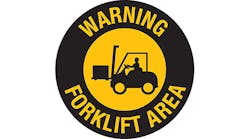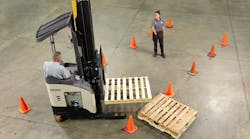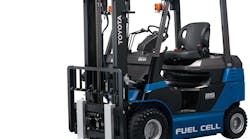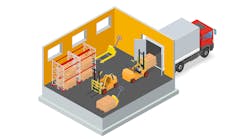The first thing—and maybe the most important thing—you learn when you participate in a Washington fly-in event is that most of the contact that U.S. industry has with the Houses of Congress is not with Senators and Congressmen, but rather with legislative assistants and aides, many of them in their 20s, which means that none of them were even alive when the current OSHA standard on forklift safety was written, back in 1969 (to put that into context, 1969 was Richard M. Nixon's first year as President).
For some time, the Industrial Truck Association (ITA), the trade group representing forklift manufacturers as well as suppliers to the industry, has been urging OSHA to update—not replace, but simply to update—that 1969 standard to reflect the advances in technology and best practices that have occurred over the intervening 40+ years. The ITA’s position is that the most recent edition of the ANSI/ITSFD B56.1 standard, from 2012, “reflects the state of the art in forklift safety.”
As Gary Cross, ITA’s counsel, puts it, “We’re not asking for a new regulation, but just that the standard recognizes that the 2012 version is an acceptable way to comply with OSHA.”
Some of the chief reasons why OSHA has yet to move on updating the regulation is that the agency has a very limited budget; the regulation process itself is long and tedious; and that OSHA has to perceive that any change or update will not be controversial—in other words, that the new rule will not impose additional costs or reduce worker protection. The ITA’s position is that the update of the standard should be uncontroversial because nobody is even using the 1969 version anymore, and that the 2012 standard reflects the ITA’s proactive measures to remain current on forklift safety.
The goal of National Forklift Safety Day, then, is for members of the ITA to get face time with their elected representatives, with the goal of soliciting their aid in convincing OSHA that the time to update the standard is now, not some undefined future date. With MH&L the exclusive media sponsor of NFSD 2015, I was invited to cover the event and to share the various industry activities associated with the event.
Congressman Reid Ribble (R-WI) was asked to speak at NFSD 2015 to offer advice on what to do when meeting with a member of the legislative branch of the U.S. Government (or at least a member of their staff). Ribble isn’t a typical politician, at least not when it comes to his background and familiarity with the real-world problems of industry. While the majority of his peers in the U.S. House of Representatives had careers in law, banking or academia, Ribble ran his own commercial and residential roofing company for 30 years. He also served as president of the National Roofing Contractors Association. So he knows first-hand what it means to run a company under the watchful eyes of the Occupational Safety and Health Administration (OSHA).
“First of all, when you’re speaking to a Congressman, remember that you’re not a constituent and you’re not a customer,” Ribble said. “You’re a citizen. And in our country, the citizens have all the power.”
Ribble then noted, “There are three types of Congressmen: the informed, the uninformed and the misinformed. And it’s the misinformed who are the hardest to deal with.” Convincing somebody whose mind was already made up, despite having been influenced by faulty or just plain wrong information, was a very difficult task. That’s why a theme of NFSD 2015 is that the ITA and OSHA have a solid working relationship, and the point of the fly-in meetings is to solidify and update the standards to make the industry safer while eliminating out-of-date redundancies or contradictions in the standard.
Drawing on his background in industry, Ribble told the ITA members,“We need to respond to safety out of a need to protect our workers, not just because we’re afraid OSHA is watching us.”
He believes that safety is all about awareness, and one of his ideas—one not likely to be embraced by OSHA any time soon—is to hold employees accountable for their adherence to safety regulations. “Until we make employees partly accountable for their own safety we’ll continue to have workplace issues,” Ribble said. He suggests that we would see immediate improvements if employees were subject to fines for their unsafe practices at the workplace.
Representing OSHA at the NFSD 2015 program was Tom Galassi, director of the Directorate of Enforcement Programs (DEP) with the Department of Labor. He declined to comment on Rep. Ribble’s idea about fining workers for unsafe practices, choosing instead to observe, “New workers are at greater risk of injury due to unfamiliarity with the workplace, and temporary workers are at even greater risk due to inadequate training.”
Temporary staffing agencies must remain in contact with workers they send to worksites, Galassi insisted. “Employers cannot assume that the staffing agencies have provided adequate training to temp workers—the employers must take responsibility for the safety of temp workers, especially since the safety of their entire workforce could be at risk,” as temp workers pose a potential hazard if they’re not familiar with proper use of equipment. “Nobody’s first day on the job should be the last day of their lives.”
Galassi also noted that “there’s no timeline in place for an update to the 1969 forklift standard, but we do take it seriously and we will be looking at it.”
Speaking for ITA members, Jay Costello, director of training with NACCO Materials Handling Group, which produces the Yale and Hyster lines of forklifts, said, “We can never talk about safety enough. There are always new people coming into the industry who have heard everything there is to know about forklift safety.”
To train forklift operators properly, companies need to dedicate the right amount of time, and hands-on, repetitive training is essential, Costello emphasized. “Training also needs to be specific to the type of vehicle being used and the type of material being moved. And pedestrian safety training is as important as operator training.”
For the ITA members, the afternoon of NFSD 2015 was spent in the offices of the Congressmen and Senators from the districts and states the companies are located in or have facilities in. Most of my visits were with legal assistants working for U.S. Senators and Representatives from Massachusetts and North Carolina (I accompanied the Trelleborg Wheel Systems group), though we did get to meet Sen. Elizabeth Warren (D-MA), who holds regular meet-and-greet cattlecalls with large groups of constituents at one time.
How effective the day was, in terms of wooing support from Congress in the quest for an updated OSHA standard, remains to be seen. Anecdotally, some of the ITA members I spoke to were glad they had a chance to make their case and were encouraged that at least some traction was made within the halls of Congress. Others, though, questioned how diluted their message might be in the hand-off from the legal aides to the Congressmen and Senators. And, as Scott Klug, a former member of Congress (R-WI, 1991-1999) and currently director of public affairs with law firm Foley & Lardner and an advisor to ITA, pointed out, “Congress is a very difficult place to get things done right now.”
Nonetheless, the third annual National Forklift Safety Day will be held in Washington, DC, on June 14, 2016.



